PetesPockets55
Bronze Member
- Joined
- Apr 18, 2013
- Messages
- 1,728
- Reaction score
- 3,142
- Golden Thread
- 0
- Location
- Indian River Co., Fl
- Detector(s) used
- AT MAX & Carrot, Nokta Pulse Dice (:
- Primary Interest:
- All Treasure Hunting
Rectangular bronze item with raised squares and mounting hole.
(Posted in "What is This" also and a burnishing tool came to mind for one person)
So I was at a monthly meeting last week and there was a demonstration given about metal detecting. The gentleman brought in a handful of artifacts he has found on a local Ft. Pierce Fl. beach (and up north). He asked the audience for help ID'ing one of them because he didn't have a clue. When I suggested posting it here because of the depth of the members knowledge, he said he didn't know anything about posting but agreed to let me.
So here goes:
Composition- Bronze
Weight- ? (No scale)
Markings- None that I noticed but there was a hole at one end (apparently for mounting to wood as the hole was tapered)
The size is approximate as we had no measuring device.
Width- +- 1.625 (1-5/8")
Length- +- 8.125 (8-1/8")
Thickness- +- .25 (1/4")
(Excluding the pointed part of the squares)
Max. Thick.- +- .50 (1/2")
Each individual square is approximately 7/16"
Some thoughts on it's purpose might be protective, dissipate heat(?), traction, "coersive persuader" , "hard noogie" device
, "hard noogie" device  , or
, or 

(The textured surface reminded me of the head of a meat tenderizing hammer!!)
I think it has a specific use (not purely decorative) because of the thickness.
At first I thought it might be to provide traction on ship stairs but there is only one mounting hole and no wear on the top of the points of the squares.
Thanks in advance for any help or suggestions.
(Posted in "What is This" also and a burnishing tool came to mind for one person)
So I was at a monthly meeting last week and there was a demonstration given about metal detecting. The gentleman brought in a handful of artifacts he has found on a local Ft. Pierce Fl. beach (and up north). He asked the audience for help ID'ing one of them because he didn't have a clue. When I suggested posting it here because of the depth of the members knowledge, he said he didn't know anything about posting but agreed to let me.
So here goes:
Composition- Bronze
Weight- ? (No scale)
Markings- None that I noticed but there was a hole at one end (apparently for mounting to wood as the hole was tapered)
The size is approximate as we had no measuring device.
Width- +- 1.625 (1-5/8")
Length- +- 8.125 (8-1/8")
Thickness- +- .25 (1/4")
(Excluding the pointed part of the squares)
Max. Thick.- +- .50 (1/2")
Each individual square is approximately 7/16"
Some thoughts on it's purpose might be protective, dissipate heat(?), traction, "coersive persuader"
 , "hard noogie" device
, "hard noogie" device  , or
, or 

(The textured surface reminded me of the head of a meat tenderizing hammer!!)
I think it has a specific use (not purely decorative) because of the thickness.
At first I thought it might be to provide traction on ship stairs but there is only one mounting hole and no wear on the top of the points of the squares.
Thanks in advance for any help or suggestions.
Amazon Forum Fav 👍
Attachments
-
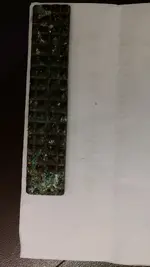 BronzeRectangleMDBeachFindObverse.webp330.4 KB · Views: 60
BronzeRectangleMDBeachFindObverse.webp330.4 KB · Views: 60 -
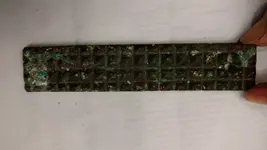 BronzeRectangleMDBeachFindHorizObverse.webp267.5 KB · Views: 67
BronzeRectangleMDBeachFindHorizObverse.webp267.5 KB · Views: 67 -
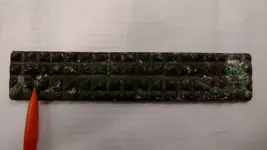 BronzeRectangleMDBeachFindObverseW_PencilAtHole.webp407.5 KB · Views: 85
BronzeRectangleMDBeachFindObverseW_PencilAtHole.webp407.5 KB · Views: 85 -
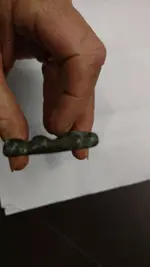 BronzeRectangleMDBeachFindShortEdge.webp127.4 KB · Views: 70
BronzeRectangleMDBeachFindShortEdge.webp127.4 KB · Views: 70 -
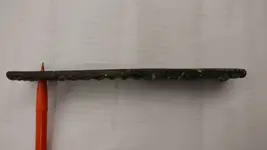 BronzeRectangleMDBeachFindLongEdgeW_PencilAt Hole.webp133.9 KB · Views: 70
BronzeRectangleMDBeachFindLongEdgeW_PencilAt Hole.webp133.9 KB · Views: 70 -
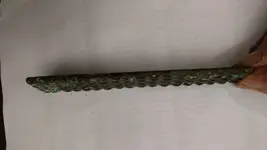 BronzeRectangleMDBeachFindLongEdge.webp167.3 KB · Views: 69
BronzeRectangleMDBeachFindLongEdge.webp167.3 KB · Views: 69 -
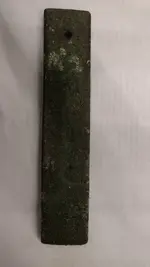 BronzeRectangleMDBeachFindReverse.webp278.6 KB · Views: 59
BronzeRectangleMDBeachFindReverse.webp278.6 KB · Views: 59




